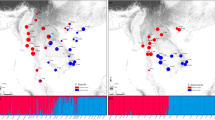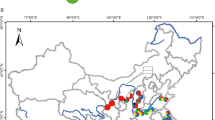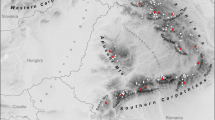Abstract
The study of fragmentation processes should be tackled using different approaches, in order to obtain solid and robust evidence that could help in identifying potential barriers and threats for species. In this study, we have evaluated the spatial fragmentation patterns in Artemisia crithmifolia (Asteraceae) along its current distribution along the Atlantic coastlines of Europe, from Portugal to the Netherlands and the UK. Niche modelling analyses considering current and past climatic conditions, combined with plastid markers, have been used to evaluate the disconnected distribution pattern of the species, genetic flow between populations and habitat suitability for present and past populations. Plastid markers showed very low variability, while suggesting that the westernmost populations from the Atlantic coast of the Iberian Peninsula are partially genetically isolated, due to the existence of a potential barrier for gene flow on the northern Spanish coast. However, niche models identify this area as a potential habitat for the species, even during the last glacial maximum (20,000 years ago). The combination of both techniques allows identification of potential refugia for the species, highlighting the most likely recolonisation routes and distribution patterns which resulted in the overall low levels of genetic diversity. Anthropogenic activities (urban sprawl, beach expansions, etc.) are most likely behind local extinctions, thus preventing the establishment and expansion of new populations.


Similar content being viewed by others
References
Aseginolaza C, Gómez D, Lizaur X, Montserrat G, Morante G, Salaverria M, Uribe-Echebarria P, Alejandre J (1985) Catálogo florístico de Álava. Vizcaya y Guipúzcoa, Gobierno Vasco Vitoria-Gasteiz
Avise JC (2000) Phylogeography: the history and formation of species. Harvard University Press, Cambridge
Baker HG (1955) Evolution of reproductive isolation in plants. Evolution 9:37–349
Castelloe J, Templeton AR (1994) Root probabilities for intraspecific gene trees under neutral coalescent theory. Molec Phylogen Evol 3:102–113. doi:10.1006/mpev.1994.1013
Clement M, Posada D, Crandall KA (2000) TCS: a computer program to estimate gene genealogies. Molec Ecol 9:1657–1659. doi:10.1046/j.1365-294x.2000.01020.x
Collins WD, Bitz CM, Blackmon ML, Bonan GB, Bretherton CS, Carton JA, Chang P, Doney SC, Hack JJ, Henderson TB (2006) The community climate system model version 3 (CCSM3). J Climate 19:2122–2143. doi:10.1175/JCLI3761.1
Coyer J, Peters A, Stam W, Olsen J (2003) Post-ice age recolonization and differentiation of Fucus serratus L. (Phaeophyceae; Fucaceae) populations in Northern Europe. Molec Ecol 12:1817–1829. doi:10.1046/j.1365-294X.2003.01850.x
Doody JP (2013) Alien plant invasion. In: Sand dune conservation, management and restoration, vol 4. Coastal Research Library. Springer, Dordrecht, pp 177–199. doi:10.1007/978-94-007-4731-9_8
Doyle JJ, Dolyle JL (1990) Isolation of plant DNA from fresh tissue. Focus 12:13–15
Dupanloup I, Schneider S, Excoffier L (2002) A simulated annealing approach to define the genetic structure of populations. Molec Ecol 11:2571–2581. doi:10.1046/j.1365-294X.2002.01650.x
Ehlers J, Gibbard PL (2004) Quaternary glaciations-extent and chronology. Part I: Europe, vol 2. Elsevier, Amsterdam
European Commission (1992) Council directive 92/43/EEC of 21 May 1992 on the conservation of natural habitats and of wild fauna and flora. Official Journal of the European Communities, series L, vol 206, pp 7–50
Feagin RA, Sherman DJ, Grant WE (2005) Coastal erosion, global sea-level rise, and the loss of sand dune plant habitats. Frontiers Ecol Environm 3:359–364. doi:10.2307/3868584
Fontaine M, Baird S, Piry S, Ray N, Tolley K, Duke S, Birkun A, Ferreira M, Jauniaux T, Llavona A, Ozturk B, Ozturk A, Ridoux V, Rogan E, Sequeira M, Siebert U, Vikingsson G, Bouquegneau J-M, Michaux J (2007) Rise of oceanographic barriers in continuous populations of a cetacean: the genetic structure of harbour porpoises in Old World waters. BMC Biol 5:30. doi:10.1186/1741-7007-5-30
Frankham R, Ballou JD, Briscoe DA (2002) Introduction to conservation genetics. Cambridge University Press, New York
Frau D, Eizaguirre BO, Arbeiza CG, de la Peña JAJ (2014) The role of the hydrodynamic regime in the distribution of the invasive shrub Bacchiris halimifolia (Compositae) in Oyambre Estuary (Cantabria, Spain). Limnetica 33:1–12
Garcia S, McArthur ED, Pellicer J, Sanderson SC, Vallès J, Garnatje T (2011) A molecular phylogenetic approach to western North America endemic Artemisia and allies (Asteraceae): Untangling the sagebrushes. Amer J Bot 98:638–653. doi:10.3732/ajb.1000386
Gredilla F (1914) Itinerarios botánicos de Dn Javier de Arízaga y relacion detallada de dos nuevos manuscritos. Diputación foral de Álava Vitoria
Gussarova G, Allen GA, Mikhaylova Y, McCormick LJ, Mirré V, Marr KL, Hebda RJ, Brochmann C (2015) Vicariance, long-distance dispersal, and regional extinction–recolonization dynamics explain the disjunct circumpolar distribution of the arctic-alpine plant Silene acaulis. Amer J Bot 102:1703–1720. doi:10.3732/ajb.1500072
Hall TA (1999) BioEdit: A user-friendly biological sequence alignment editor and analysis program for Windows 95/98/NT. Nucl Acids Symp Ser 41:95–98
Hamilton MB (1999) Four primer pairs for the amplification of chloroplast intergenic regions with intraspecific variation. Molec Ecol 8:521–523
Hasumi H, Emori S (2004) K-1 coupled model (MIROC) description. K-1 Technical Report 1. Center for Climate System Research, University of Tokyo, Tokyo
Helmuth B, Harley CD, Halpin PM, O’Donnell M, Hofmann GE, Blanchette CA (2002) Climate change and latitudinal patterns of intertidal thermal stress. Science 298:1015–1017. doi:10.1126/science.1076814
Heslenfeld P, Jungerius P, Klijn J (2004) European coastal dunes: ecological values, threats, opportunities and policy development. In: Martínez ML, Psuty NP (eds) Coastal dunes. Springer, Berlin, pp 335–351
Hewitt GM (1999) Post-glacial re-colonization of European biota. Biol J Linn Soc 68:87–112. doi:10.1111/j.1095-8312.1999.tb01160.x
Hijmans RJ, Cameron SE, Parra JL, Jones PG, Jarvis A (2005) Very high resolution interpolated climate surfaces for global land areas. Int J Climatol 25:1965–1978. doi:10.1002/joc.1276
Hoarau G, Coyer J, Veldsink J, Stam W, Olsen J (2007) Glacial refugia and recolonization pathways in the brown seaweed Fucus serratus. Molec Ecol 16:3606–3616. doi:10.1111/j.1365-294X.2007.03408.x
Huang J, Cang H, Liu Q, Shao J (2013) Environment friendly inhibitor for mild steel by Artemisia halodendron. Int J Electrochem Sci 8:8592–8602
Kadereit JW, Arafeh R, Somogyi G, Westberg E (2005) Terrestrial growth and marine dispersal? Comparative phylogeography of five coastal plant species at a European scale. Taxon 54:861–876. doi:10.2307/25065473
King RA, Ferris C (1998) Chloroplast DNA phylogeography of Alnus glutinosa (L.) Gaertn. Molec Ecol 7:1151–1161. doi:10.1046/j.1365-294x.1998.00432.x
Kyrkou I, Iriondo JM, García-Fernández A (2015) A glacial survivor of the alpine Mediterranean region: phylogenetic and phylogeographic insights into Silene ciliata Pourr. (Caryophyllaceae). PeerJ 3:e1193. doi:10.7717/peerj.1193
Lang G (1994) Quartäre Vegetationsgeschichte Europas: Methoden und Ergebnisse. Spektrum Akademischer Verlag, Heidelberg
Laursen S, Reiners W, Kelly R, Gerow K (2007) Pollen dispersal by Artemisia tridentata (Asteraceae). Int J Biometeorol 51:465–481. doi:10.1007/s00484-007-0086-7
Lundy CJ, Rico C, Hewitt GM (2000) Temporal and spatial genetic variation in spawning grounds of European hake (Merluccius merluccius) in the Bay of Biscay. Molec Ecol 9:2067–2079. doi:10.1046/j.1365-294X.2000.01120.x
Maggs CA, Castilho R, Foltz D, Henzler C, Jolly MT, Kelly J, Olsen J, Perez KE, Stam W, Väinölä R, Viard F, Wares J (2008) Evaluating signatures of glacial refugia for North Atlantic benthic marine taxa. Ecology 89:S108–S122. doi:10.1890/08-0257.1
McArthur ED (1994) Ecology, distribution, and values of sagebrush within the Intermountain region. In: Proceedings—ecology and management of annual rangelands. USDA Forest Service General Technical Report, pp 347–351
Médail F, Diadema K (2009) Glacial refugia influence plant diversity patterns in the Mediterranean Basin. J Biogeogr 36:1333–1345. doi:10.1111/j.1365-2699.2008.02051.x
Nieto Feliner G (2014) Patterns and processes in plant phylogeography in the Mediterranean Basin. A review. Perspect Pl Ecol Evol Syst 16:265–278. doi:10.1016/j.ppees.2014.07.002
Oberprieler C, Himmelreich S, Vogt R (2007) A new subtribal classification of the tribe Anthemideae (Compositae). Willdenowia 37:89–114. doi:10.3372/wi.37.37104
Occhipinti-Ambrogi A (2007) Global change and marine communities: alien species and climate change. Mar Pollut Bull 55:342–352. doi:10.1016/j.marpolbul.2006.11.014
Patsiou TS, Conti E, Zimmermann NE, Theodoridis S, Randin CF (2014) Topo-climatic microrefugia explain the persistence of a rare endemic plant in the Alps during the last 21 millennia. Global Change Biol 20:2286–2300. doi:10.1111/gcb.12515
Pellicer J, Garcia S, Garnatje T, Vallès J (2009) Changes in genome size in a fragmented distribution area: the case of Artemisia crithmifolia L. (Asteraceae, Anthemideae). Caryologia 62:152–160. doi:10.1080/00087114.2004.10589680
Petit RJ, Aguinagalde I, de Beaulieu J-L, Bittkau C, Brewer S, Cheddadi R, Ennos R, Fineschi S, Grivet D, Lascoux M, Mohanty A, Müller-Starck G, Demesure-Musch B, Palmé A, Martín JP, Rendell S, Vendramin GG (2003) Glacial refugia: hotspots but not melting pots of genetic diversity. Science 300:1563–1565. doi:10.1126/science.1083264
Phillips SJ, Dudík M (2008) Modeling of species distributions with Maxent: new extensions and a comprehensive evaluation. Ecography 31:161–175. doi:10.1111/j.0906-7590.2008.5203.x
Pingree RD (1993) Flow of surface waters to the west of the British Isles and in the Bay of Biscay. Deep-Sea Res 2: Topical Stud Oceanogr 40:369–388. doi:10.1016/0967-0645(93)90022-F
Poff N, Brinson MM, Day J (2002) Aquatic ecosystems and global climate change. Pew Center on Global Climate Change, Arlington
Provan J, Maggs CA (2012) Unique genetic variation at a species’s rear edge is under threat from global climate change. Proc Roy Soc Biol Sci Ser B 279:39–47. doi:10.1098/rspb.2011.0536
Richards AJ (1997) Plant breeding systems. Garland Science, New York
Riggins CW, Seigler DS (2012) The genus Artemisia (Asteraceae: Anthemideae) at a continental crossroads: Molecular insights into migrations, disjunctions, and reticulations among Old and New World species from a Beringian perspective. Molec Phylogen Evol 64:471–490. doi:10.1016/j.ympev.2012.05.003
Roman J, Darling JA (2007) Paradox lost: genetic diversity and the success of aquatic invasions. Trends Ecol Evol 22:454–464. doi:10.1016/j.tree.2007.07.002
Rozas J, Sánchez-DelBarrio JC, Messeguer X, Rozas R (2003) DnaSP, DNA polymorphism analyses by the coalescent and other methods. Bioinformatics 19:2496–2497. doi:10.1093/bioinformatics/btg359
Ruiz GM, Fofonoff PW, Carlton JT, Wonham MJ, Anson HH (2000) Invasion of coastal marine communities in North America: apparent patterns, processes, and biases. Annual Rev Ecol Syst 31:481–531. doi:10.2307/221741
Sanz M, Schönswetter P, Vallès J, Schneeweiss GM, Vilatersana R (2014) Southern isolation and northern long-distance dispersal shaped the phylogeography of the widespread, but highly disjunct, European high mountain plant Artemisia eriantha (Asteraceae). Bot J Linn Soc 174:214–226. doi:10.1111/boj.12132
Shaw J, Lickey EB, Schilling EE, Small RL (2007) Comparison of whole chloroplast genome sequences to choose noncoding regions for phylogenetic studies in angiosperms: the tortoise and the hare III. Amer J Bot 94:275–288. doi:10.3732/ajb.94.3.275
Smith P (2016) Botanical interest of Crosby sand-dunes. Available at: http://activenaturalist.org.uk/mbb/node/363. Accesed 14 July 2016
Thompson JD, Higgins DG, Gibson TJ (1994) CLUSTAL W: improving the sensitivity of progressive multiple sequence alignment through sequence weighting, position-specific gap penalties and weight matrix choice. Nucl Acids Res 22:4673–4680. doi:10.1093/nar/22.22.4673
Tkach NV, Hoffmann MH, Röser M, Korobkov AA, Von Hagen KB (2008) Parallel evolutionary patterns in multiple lineages of artic Artemisia L. (Asteraceae). Evolution 62:184–198. doi:10.1111/j.1558-5646.2007.00270.x
Vallès J (1989) Dades sobre la biologia d’especies iberico-baleariques d’Artemisia L. Collect Bot 17:237–245
Vallès J, Garcia Giménez S, Hidalgo O, Martín J, Pellicer J, Sanz M, Garnatje T (2011) Biology, genome evolution, biotechnological issues and research including applied perspectives in Artemisia (Asteraceae). Advances Bot Res 60:349–419. doi:10.1016/B978-0-12-385851-1.00015-9
van Andel TH (2002) The climate and landscape of the middle part of the Weichselian glaciation in Europe: The Stage 3 Project. Quatern Res 57:2–8. doi:10.1006/qres.2001.2294
Weising K, Freitag H (2007) Phylogeography of halophytes from European coastal and inland habitats. Zool Anz 246:279–292. doi:10.1016/j.jcz.2007.07.005
Wethey DS, Brin LD, Helmuth B, Mislan K (2011) Predicting intertidal organism temperatures with modified land surface models. Ecol Modelling 222:3568–3576. doi:10.1016/j.ecolmodel.2011.08.019
Acknowledgements
The authors thank S. Garcia, D. Guest, C. Ibarria, A. Jones, Ph. Smith, J.D. Twibell, M. Wilcox and J. Woodman for their help during field sampling and S. Pyke and A. Plant for language editing. The study has been supported by Projects CGL2007-64839-C02-01/-02, CGL2010-22234-C02-01.02/BOS and CGL2013-49097-C2-2-P (Spanish Government) and 2014SGR514 (Catalan Government).
Author information
Authors and Affiliations
Corresponding author
Additional information
Handling editor: Christian Parisod.
Electronic supplementary material
Below is the link to the electronic supplementary material.
Information on Electronic Supplementary Material
Information on Electronic Supplementary Material
Online Resource 1. Description of the environmental (BIOCLIM) variables used to construct ecological niche models in Maxent.
Online Resource 2. Genbank reference numbers for the sequences obtained for each marker.
Online Resource 3. Alignment of psbA-trnH region used for the analysis of Artemisia crithmifolia.
Online Resource 4. Alignment of rpl32-trnL region used for the analysis of Artemisia crithmifolia.
Online Resource 5. Results of the jackknife test on the importance of the environmental variables, showing the gain in predictive (regularised training gain) when the different variables are used in isolation and the decrease in the gain when each of them is omitted.
Rights and permissions
About this article
Cite this article
García-Fernández, A., Vitales, D., Pellicer, J. et al. Phylogeographic insights into Artemisia crithmifolia (Asteraceae) reveal several areas of the Iberian Atlantic coast as refugia for genetic diversity. Plant Syst Evol 303, 509–519 (2017). https://doi.org/10.1007/s00606-017-1387-x
Received:
Accepted:
Published:
Issue Date:
DOI: https://doi.org/10.1007/s00606-017-1387-x




